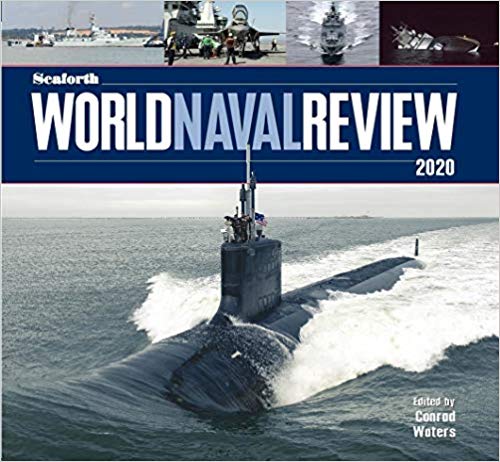
Seaforth World Naval Review 2020. Conrad Waters ed. Seaforth Publishing, Barnsley, 2020.
Reviewed by Tim Coyle
The annual World Naval Review (WNR) presents a wealth of contemporary naval information in a handy and concise publication. Half of the book reviews the state of navies in Regional Reviews: North and South America, Asia and the Pacific, the Indian Ocean and Africa, Europe and Russia. Supported by largely recent images of ships and submarines relative to the text, the larger navies’ statuses are expanded by Tables detailing principal units in commission as at mid-2019. The major naval players, the US and China and Russia (to a lesser extent) are well represented.
WNR’s second part, Fleet Review, focusses on individual navies in detail; for this edition the Royal, German and Finnish navies are examined. The Royal Navy is engaged in a major force structure revitalisation with the two new Queen Elizabeth class (QEC) aircraft carriers entering service and working up their F-35B Short Take-Off and Vertical Landing (STOVL) Joint Strike Fighter (JSF) air groups. With this new capability the RN has a new global strategy in which the carrier group may expect to be seen in regions long left without a RN presence – specifically the Indo-Pacific. There are new frigate and submarine programs – the Types 26 and 31e frigates and the Astute and Dreadnought submarine projects. The Fleet Air Arm, mine countermeasures, amphibious operations, weapons systems and the Royal Fleet Auxiliary (RFA) are all summarised with good supporting imagery.
The German Navy is also undergoing a revamp which will increase its platforms over the next decade. Features of this coverage include modernisation and procurement plans, multinational cooperation, details of current surface and subsurface units and naval organisation. While again supported by good imagery and Tables of fleet details, the narrative is disappointingly general, in the style of a public relation handout rather than an in-depth analysis of capabilities. A diagram labelled Inventory Development, showing fleets details at 2018 and 2030 is unreadable. The article would have benefitted from a concentration on a readable diagram with supporting text. Additionally, more mention might have been made of the German Navy’s new Baden-Wurttemberg FFGs with a technical description and evaluation.
The inclusion of the Finnish Navy is a contrast to the previous two large navies, but its order-of-battle and threat profile is worthy of study. Finland’s generational protagonist was the USSR, now Russia and its principal naval units of small attack craft, mine countermeasures vessels, amphibious craft and coastal missile batteries reflect this on-going strategic threat.
The third part of the book, Significant Ships, offers detailed analyses of the Indian Navy’s Kamorta class corvettes, the RFA’s new four unit ‘Tide’ class fleet tankers, together with the Royal Norwegian Navy’s ‘Maud’ replenishment ship, and the US Navy’s Virginia class nuclear attack submarines.
The Indian Kamorta class is an indigenous design – a high strategic priority in Indian defence policy. This objective analysis highlights the difficulties met in this program which has left some weapons systems unfitted. The RFA Tide class exemplifies navies now turning to replacement of auxiliary vessels which have been lower acquisition priorities in recent years. The Tide class and the Norwegian Maud are example of the ‘Aegir’ innovative design; the Tides are designed to replenish the RN QECs on extended deployments and Maud is configured for a highly flexible logistic support and command and control role. The Virginia class is of interest to Australian readers as this class was mooted as a possible candidate for the new Australian submarine program to replace the Collins class; however, political and technical issues precluded this possibility.
Finally, Technological Review, examines World Naval Aviation developments, Future Submarine Technology and Building Brazil’s Future Submarine Capability.
Of the many issues canvassed in World Naval Aviation, perhaps the most intriguing is the number of navies considering operating the F-35B STOVL JSF from adapted amphibious ships and helicopter carriers. Japan has announced its ‘helicopter-carrying destroyer’ Izumi will operate the F-35B as has Italy with Spain and South Korea considering this capability. Australia, with its two Spanish-designed Amphibious Assault Ships, may well be future candidates to operate the F-35B; however, this would be a fraught political and capability issue best left to informed speculation!
Finally, Brazil’s ambitious submarine program can be contrasted with Australia’s new submarine project. France’s Naval Group is the major contractor for both the Brazilian and Australian projects. Under the Brazilian PROSUB project, four diesel-electric Scorpene type boats are under construction at a large greenfield building facility. Additionally, Naval Group is assisting Brazil’s long-tern nuclear-submarine project which will use the Scorpene design, in contrast to the Australian project in which a nuclear hull will be reconfigured to diesel electric. The complexity and expense of the Brazilian project may well be a cautionary tale for other counties should they wish to join the nuclear submarine club!
The book’s contributors include the US naval analyst Norman Friedman (the Virginia class and Future Submarine Technologies) and former Royal Navy aviator David Hobbs (World Naval Aviation). WNR is a detailed snapshot of world navies in 2020 while digging deeply into an eclectic variety of multinational projects while looking to the future in evolving technology. It is highly recommended to anyone seeking a comprehensive, timely and compact summary of 2020 naval developments.



